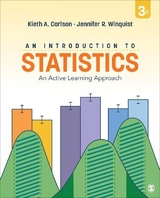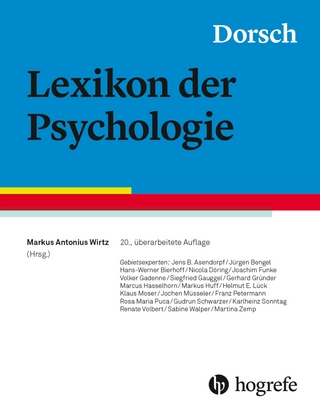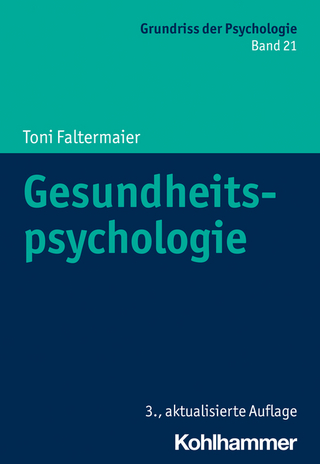
An Introduction to Statistics
SAGE Publications Inc (Verlag)
978-1-4833-7873-2 (ISBN)
- Titel erscheint in neuer Auflage
- Artikel merken
The authors encourage an active approach to learning statistics through many in-depth activities that give students the opportunity to test or demonstrate their understanding of statistical concepts. The Second Edition is based on contemporary research on memory and the "testing effect" which requires students to answer questions to facilitate their long-term retention.
Kieth A. Carlson received his PhD in Experimental Psychology with an emphasis in Cognitive Psychology from the University of Nebraska in 1996. He is currently Professor of Psychology at Valparaiso University. He has published research on visual attention, memory, student cynicism toward college, and active learning. He enjoys teaching a wide range of courses including statistics, research methods, sensation and perception, cognitive psychology, learning psychology, the philosophy of science, and the history of psychology. Dr. Carlson was twice honored with the Teaching Excellence Award from the United States Air Force Academy. Jennifer R. Winquist is currently Professor of Psychology at Valparaiso University. Dr. Winquist received her PhD in Social Psychology from the University of Illinois at Chicago and her bachelor’s degree in Psychology from Purdue University. She has published research on self-focused attention, group decision making, distributive justice, and the scholarship of teaching and learning. Dr. Winquist regularly teaches courses in introductory and advanced statistics and research methods.
Preface
About the Authors
1 Introduction to Statistics and Frequency Distributions
How to Be Successful in This Course
Math Skills Required in This Course
Why Do You Have to Take Statistics?
Statistics and the Helping Professions
Hypothesis Testing, Effect Size, and Confidence Intervals
Testing Causal Hypotheses
Populations and Samples
Independent and Dependent Variables
Scales of Measurement
Discrete Versus Continuous Variables
Graphing Data
Shapes of Distributions
Frequency Distribution Tables
SPSS
Overview of the Activity
Chapter 1 Practice Test
2 Central Tendency
Central Tendency
Computing the Mean
Find the Median
Find the Mode
SPSS
Overview of the Activity
Chapter 2 Practice Test
3 Variability
Population Variability
Steps in Computing a Population’s Standard Deviation
Sample Variability
SPSS
Overview of the Activity
Chapter 3 Practice Test
4 z Scores
z for a Single Score
Using X to Find Important “Cut Lines”
z Scores and the Standard Normal Curve
Example 1: Positive z Score
Example 2: Negative z Score
Example 3: Proportion Between Two z Scores
Overview of the Activity
Chapter 4 Practice Test
5 The Distribution of Sample Means and z for a Sample Mean
Sampling and Sampling Error
Distribution of Sample Means
z for a Sample Mean
Example: Computing and Interpreting the z for a Sample Mean
Exact Probabilities Versus Probability Estimates
Overview of the Activities
Chapter 5 Practice Test
6 Hypothesis Testing With z Scores
Introduction to Hypothesis Testing
Hypothesis Testing With z for a Sample Mean Example (One-Tailed)
What Does It Mean to Describe Something as “Statistically Significant”?
Errors in Hypothesis Testing
Hypothesis Testing Rules
What Is a p Value?
Why Statisticians “Fail to Reject the Null” Rather Than “Accept the Null”
Why Scientists Say “This Research Suggests” Rather Than “This Research Proves”
Overview of the Activities
Chapter 6 Practice Test
7 Single-Sample t Test
Single-Sample t Test
Conceptual Information
One-Tailed Single-Sample t Test Example
Two-Tailed Single-Sample t Test Example
Other Alpha Levels
SPSS
Overview of the Activity
Chapter 7 Practice Test
8 Estimation With Confidence Intervals
Three Statistical Procedures With Three Distinct Purposes
Logic of Confidence Intervals
Computing a Confidence Interval for a Population Mean
Computing Confidence Intervals for a Mean Difference
Reporting Confidence Intervals in APA Style
Confidence Intervals for Effect Sizes
Interpretations of Confidence Intervals
SPSS
Overview of the Activity
Chapter 8 Practice Test
9 Related Samples t Test
Repeated/Related Samples t Test
Logic of the Single-Sample and Repeated/Related Samples t Tests
Related Samples t (Two-Tailed) Example
Related Samples t (One-Tailed) Example
Statistical Results, Experimental Design, and Scientific Conclusions
SPSS
Overview of the Activities
Chapter 9 Practice Test
10 Independent Samples t Test
Independent Samples t
Conceptual Formula for the Independent Samples t
Two-Tailed Independent t Test Example
One-Tailed Independent t Test Example
Other Alpha Levels
SPSS
Overview of the Activities
Chapter 10 Practice Test
11 One-Way Independent Samples ANOVA
Independent Samples ANOVA
An Example ANOVA Problem
An Additional Note on ANOVAs: Family-Wise Error and Alpha Inflation
SPSS
Overview of the Activities
Chapter 11 Practice Test
12 Two-Factor ANOVA or Two-Way ANOVA
Purpose of the Two-Way ANOVA
Describing Factorial Designs
Logic of the Two-Way ANOVA
Example of a Two-Way ANOVA
SPSS
Overview of the Activities
Chapter 12 Practice Test
13 Correlation and Regression
When to Use Correlations and What They Can Tell You
Review of z Scores
The Logic of Correlation
Direction and Strength of Correlation Coefficients
Computational Formulas
Spearman’s (rs) Correlations
Using Scatterplots Prior to Correlation Coefficients
Alternative Use for Correlation
Correlation and Causation
Hypothesis Testing With Correlation
Two-Tailed Pearson’s Correlation Example
One-Tailed Pearson’s Correlation Example
What If You Need to Do a Spearman’s Correlation?
Confidence Intervals
SPSS
Overview of the Activities
Chapter 13 Practice Test
14 Goodness of Fit and Independence Chi-Square Statistics
Overview of Chi-Square
Logic of the Chi-Square Test
Comparing the Goodness-of-Fit Chi-Square and the Chi-Square for Independence
Goodness-of-Fit Chi-Square Example
Chi-Square for Independence
SPSS
Overview of the Activities
Chapter 14 Practice Test
Appendices
Appendix A
Unit Normal Table (z Table)
Appendix B
One-Tailed Probabilities t Table
Two-Tailed Probabilities t Table
Appendix C
F Table (a = .05)
F Table (a = .01)
Appendix D
The Studentized Range Statistic (q) Table
Appendix E
One-Tailed Pearson’s Correlation Table
Two-Tailed Pearson’s Correlation Table
Appendix F
Spearman’s Correlation Table
Appendix G
Fisher r to z Table
Appendix H
Critical Values for Chi-Square
Appendix I
Computing SSs for Factorial ANOVA
Appendix J
Choosing Correct Test Statistics
Index
| Erscheinungsdatum | 22.02.2017 |
|---|---|
| Verlagsort | Thousand Oaks |
| Sprache | englisch |
| Maße | 187 x 231 mm |
| Gewicht | 1050 g |
| Themenwelt | Geisteswissenschaften ► Psychologie ► Allgemeines / Lexika |
| Mathematik / Informatik ► Mathematik ► Statistik | |
| ISBN-10 | 1-4833-7873-X / 148337873X |
| ISBN-13 | 978-1-4833-7873-2 / 9781483378732 |
| Zustand | Neuware |
| Haben Sie eine Frage zum Produkt? |
aus dem Bereich



